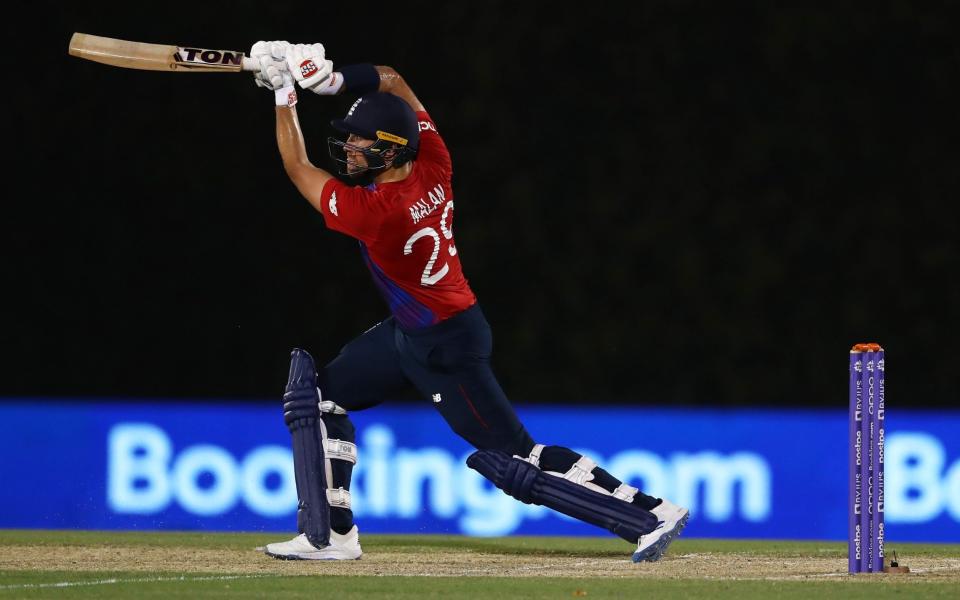England lose to India in T20 World Cup warm-up – what did we learn?

England (188-5; Bairstow 49, Ali 43) lost to India (192-3; Kishan 70, Rahul 51) by seven wickets with six balls remaining
England lost to India by seven wickets in their first warm-up for the T20 World Cup. Telegraph Sport assesses what we learnt from the encounter.
Eoin Morgan is setting about regaining form in his own way
How do you regain your form after an abject IPL season that brought 133 runs at 11.1 apiece? If you’re Eoin Morgan captaining England in their first warm-up match before the T20 World Cup, you choose to watch from the sidelines rather than be part of the final 11.
It was, in many ways, a quintessential Morgan answer. He has always been marked by an unusual single-mindedness, even by the standards of professional sport, concerned only with the best thing to do, not expediency. He also has a penchant for returning from breaks from the game and immediately relocating his form. And we should be of no doubt: Morgan’s decision to rest, while it may appear curious, was simply his judgement about what was best with Saturday’s clash with the West Indies in mind.
The Dawid Malan question remains
For much of the last two years, the great debate about England’s T20 side has concerned Dawid Malan - and whether the runs he scores make up for the lethargy with which he starts his innings. Five days before England’s World Cup opener, Malan chose an inopportune moment to give a reminder of the downsides of selecting him. He had reached 18 - including a fine inside-out extra cover drive off Ravichandran Ashwin - by the time he was clean bowled by a googly from Rahul Chahar. As often the case with Malan in T20, the problem was less the runs that he had made than how long he had taken to make them: 18 balls. In the same period, Jonny Bairstow had reached 23, and Liam Livingstone 29.
The question about Malan is particularly acute because of a trend in the Indian Premier League and the initial stages of the first round of the T20 World Cup. On turgid pitches it has been hard for teams to accelerate - “it’s like the air goes out of the ball,” Australia’s captain Aaron Finch has said - placing a premium on attacking during the Powerplay. In the 31 matches in the second stage of the IPL, 23 were won by the side making more runs in the Powerplay.
For a more enterprising alternative to Malan at number three, England could promote Moeen Ali, who sometimes batted there for the IPL winners Chennai Super Kings. While Moeen’s sparkling 20-ball 43 not out were a reminder of his batting qualities, Morgan will return to number six, leaving three as the only possible vacancy should Moeen bat in the top six.

Jonny Bairstow should not be moved from number four
The most significant tweak to England’s T20 batting line-up in the last year has been shuffling Jonny Bairstow down the order. Amid much discussion about whether Jos Buttler should be used at four, on account for his prowess against spin and power at the death, Bairstow has embraced doing exactly the role some envisaged for Buttler. In the last year batting at number four for England, Bairstow is averaging 45, at a strike rate of 144. Like Buttler, he is such an outstanding T20 player that he has mastered two different roles. His rapid 49 against India was a perfect encapsulation of why, for England, he should remain at number four.
England’s quest for new ball wickets continues
In T20, wickets are more valuable the earlier in the innings a team takes them. With Jofra Archer injured, England's quest for early wickets led to recalls for both David Willey and Chris Woakes for the World Cup.
Yet their new ball swing did not yield a single wicket in the Powerplay against India. While Willey could be content with his new ball burst of 0-10 from new overs - which included Woakes spilling a chance at mid on - Woakes’s length was uncharacteristically awry. His second over leaked 18 runs as he overmatched to KL Rahul. England have deep trust that Woakes’s qualities can overcome a dearth of T20 cricket in recent years, but this was a chastening start. A better balanced attack would be to omit one of Woakes or Willey, bring in Tymal Mills for his prowess at the death and use Mark Wood more with the new ball.
Pace will have to win it for England
It is instructive to compare the squads of the two tournament favourites. While India have four bowlers who could be considered specialist spinners, England have adopted an antithetical approach, and only have Adil Rashid. Even he looks a little short of his customary excellence: Rashid’s three overs yielded 36, one run more expensive than his three overs in his lone IPL game.
England’s selection defies historic trends: spin has been more economical than seam in every over of T20 cricket. Yet there is a certain rationale in England’s approach, too. Partly, it reflects the supply of bowling talent in the English game, even with Archer and Sam Curran injured: England are simply far better-stocked with seamers. More intriguing - and hopeful for England - is the idea that dew might be a major factor in games this tournament. Dew tends to hinder spinners more than seamers; if conditions defy conditions to neuter spin, England will find themselves with an unexpected tactical advantage over the rest of the field.

 Yahoo Sport
Yahoo Sport 





































